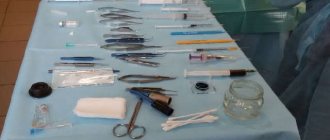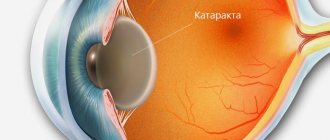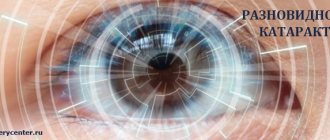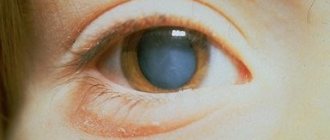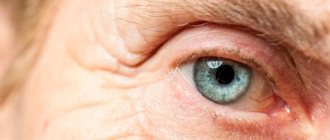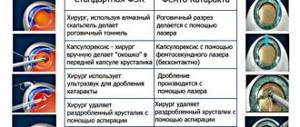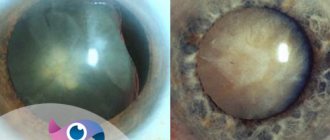Cataracts are a dangerous disease caused by changes in the lens of the eye.
It becomes cloudy, vision deteriorates sharply until it is completely lost.
During cataract surgery, the cloudy lens is emulsified and removed with a needle. Then the lens is replaced with an artificial one. This operation is quite traumatic and requires subsequent recovery. Eye drops are part of complex postoperative therapy.
How is cataract surgery performed?
To understand what the postoperative period will be like, it is worth learning in detail about what the patient experiences during manipulations to replace the eye lens for cataracts.
In this article
- How is cataract surgery performed?
- How the artificial lens model affects recovery after surgery
- Possible complications after lens replacement for cataracts
- How quickly does vision return after lens replacement for cataracts?
- Implantation of an artificial lens: features of the postoperative period
- What will vision be like after lens replacement for cataracts?
In the minds of many people who are awaiting lens replacement due to cataract opacity, the operation is still dangerous, complex, painful and associated with a high risk of complete blindness. Although nowadays lens replacement operations are performed everywhere, small punctures through which the lens is exposed and an intraocular lens is implanted heal without the need for sutures within a few days. Due to the low invasiveness of eye lens replacement, healing occurs quickly and in most cases without complications.
Ultrasonic phacoemulsification - the main stages of lens replacement for cataracts:
- preparing the patient for lens replacement: on the eve of surgery, it is necessary to exclude the consumption of fatty, spicy foods, alcohol, and normalize sleep and rest patterns;
- local anesthesia using special eye drops;
- To replace the clouded lens, several punctures of the cornea are performed;
- Through a micro-incision, ultrasound acts on the clouded lens, crushing it, and the injected viscoelastic transforms the fragments into a homogeneous emulsion, which is removed through the probe;
- The lens capsule is carefully cleaned and polished, then an intraocular lens is inserted into it, unfolded inside and secured.
Torsion ultrasound is the most effective. Recovery after lens replacement using such equipment will be quick. This ultrasound works carefully and safely, since the exposure time on the eye structures is short. The operation can also be performed using a laser. It does not puncture, but gently separates the cornea. The hole is smooth, with perfect alignment. This method of lens replacement is suitable for people for whom ultrasound exposure is contraindicated.
RULES FOR INBURIATION OF DROPS
- Wash your hands thoroughly.
- Open the bottle.
- Tilt your head back or lie on your back and look up.
- Place the bottle upside down over your eye, avoiding touching your eye and eyelashes.
- Gently grasp the lower eyelid with your fingers and pull it down slightly.
- Turn your eye upward and squeeze the bottle slightly so that the drop falls into the space formed between the eyeball and the retracted lower eyelid.
- Close your eye.
- To enhance the effectiveness of the effect and minimize the systemic side effects of eye drops, press the inner corner of the canthus with your index finger (through a sterile napkin).
- When prescribing several drops, the interval between instillations should be about 5 minutes.
- Cap the bottle and store it as directed.
(43Kb, Adobe PDF format)
How the artificial lens model affects recovery after surgery
How quickly can you recover from cataract surgery? Everything depends not only on the individual characteristics of the person, but also on the model of the lens. The capabilities of modern equipment that is used during cataract extraction make it possible to significantly reduce the size of the incision, and now the lens can be implanted into the capsule through an incision of 1.8-2 mm, and not through 6 mm, as was previously the case.
Therefore, it is worth choosing newer lens models made of soft, elastic material. Such lenses are implanted in a folded form, and then unfold independently and are secured in the capsule using support elements.
How to choose a lens? What should it be like:
- ensure high visual acuity, clarity, brightness and contrast of images;
- minimize the amount of optical distortion - this task is effectively handled by lenses in an aspherical design, thanks to which the rays are refracted evenly and a person does not feel discomfort from glare;
- the presence of a UV filter and a yellow filter - they protect the eyes from exposure to sunlight and the blue part of ultraviolet radiation.
It is easier to get used to a high-quality lens that most accurately imitates the natural lens of the human eye, since the brain, which takes part in processing visual information, quickly adapts to familiar conditions. The newer and better quality the cataract lens model is, the faster the recovery period will be. Surgeons try to recommend lenses taking into account the patient’s financial capabilities, offering the most optimal option. Older lens models will be implanted through a large incision due to imperfect lens architecture, which means it will take longer to restore full vision. At the same time, there is a risk of developing complications in the form of recurrent cataracts, increased intraocular pressure, etc. will increase.
Preparing for surgery
Preparation for replacing an artificial eye lens is planned in advance by an ophthalmologist and it is often necessary to follow the following recommendations:
- all diagnostic measures are carried out as prescribed by the ophthalmologist;
- the ophthalmologist is notified of the presence of concomitant pathologies;
- the patient must be informed what dosage forms he is taking to eliminate the symptoms of concomitant diseases;
- 8 hours before surgery, food intake is excluded;
- at night you are allowed to take sedatives (tincture of Motherwort or Valerian);
- in some cases, a course of antibacterial drops is prescribed before surgery.
Possible complications after lens replacement for cataracts
Restoring vision after cataract removal takes a short period if the surgery was performed by a qualified specialist in a well-equipped, modern clinic.
Among the common complications after lens replacement is the problem of secondary cataracts, which develops several months after the operation. In this case, recovery after lens replacement will be complicated by clouding of the posterior capsule, due to which the person will again experience discomfort caused by unclear, blurred images.
Possible complications during the recovery period after cataract removal:
- inflammation of the iris is a common complication, goes away on its own after a few days, and is associated with healing processes;
- displacement of the intraocular lens towards the retina - this complication is often associated with the initially incorrect position of the lens when implanted into the eye capsule, often depends on the quality of the supporting elements of the lens;
- increased intraocular pressure, hemorrhage in the anterior chamber, retinal detachment;
- secondary cataract - may be a consequence of incomplete removal of epithelial cell fragments, which continue to grow and move into the optical zone, thereby significantly reducing the quality of vision.
The risk of developing secondary cataracts is high when using simple, imperfect lens designs that will require a large corneal incision for implantation. New types of lenses made of soft, elastic materials are developed with special design features of the supporting elements, thereby creating an obstacle to the growth of tissue under the lens. With them, vision is restored faster. If epithelial growth does occur on the back of the lens, the patient will be offered a repeat operation to clean the lens using a YAG laser.
Effective medicines
Vitafacol eye drops for cataracts improve vision and the energy balance of the lens. They have minor side effects: redness and burning. Oftan Katahrom is a popular combined action product that restores tissue and protects against free radicals. It is used for partial or complete clouding of the lens. The composition includes citrochrome C, sodium phosphate, adenosine, nicotinamide. Citrochrome provides protective properties due to the fact that it binds free radical molecules. Denosine improves blood circulation, promotes the production of intraocular fluid, preventing the development of the inflammatory process. Nicotinamide regenerates tissues and prevents the development of pathology. Ophthalmic agents have a good effect and act quickly, have an antiseptic and anti-inflammatory effect. Since cataracts are accompanied by dry eyes, these drops are also used for moisturizing. Oftan Katahrom is prescribed for the treatment of diseases of various origins, as well as for the prevention of pathology. You need to use 1-2 drops 3 times a day. The duration of the treatment course depends on the stage of cataract and pathogenesis. Eye drops for cataracts Taufon are effective, they are an energetic and metabolic agent that has a beneficial effect on the entire eye. The product is a sulfur-containing amino acid, which helps normalize intraocular fluid pressure, tissue regeneration, and activation of energy processes. The main component is taurine. An allergic reaction is possible as a side effect. Used to treat diabetic, senile, traumatic, radiation cataracts. The drops must be used without interruption for 3 months, and after a month the treatment course must be repeated. You need to drip 1-2 drops 4 times a day. Quinax activates proteolytic enzymes, which promote the resorption of protein compounds that are opaque. The main component is azapentacene. The action of this medicine is similar to the action of Oftan Katahroma. The product promotes rapid restoration of metabolic processes in tissues. In addition, the lens of the eye is protected from oxidative effects. Quinax is prescribed for the treatment of the following forms of cataracts: traumatic, senile, secondary, congenital. The product should be used up to 5 times a day. They are well tolerated, sometimes an allergic reaction is possible due to individual intolerance to the main or auxiliary components. Visomitin has antioxidant and anti-inflammatory properties. The drops moisturize, eliminate burning, redness, and stimulate the production of intraocular fluid. This drug is also called Skulachev drops, in honor of the academician who invented them. The scientist himself suffered from cataracts, so he created this remedy, which helped him get rid of the disease within a year, and did not even require surgery. Chinese eye drops for treating cataracts are effective. And their maximum effect occurs when cataracts are caused by age-related changes. Most often, such drops are used by people over 65 years of age. This drug normalizes metabolic processes, which are manifested by low energy metabolism of the lens. Chinese drops slow down the destruction process and improve vision. At the initial stage of cataract of senile pathogenesis, the effectiveness reaches 100%. This is due to the fact that the substances that make up the drops penetrate deep into the aqueous and lipid environments of the eye, which prevents damage and restores integrity. This can improve vision. You need to bury the product in your eyes every day, 1-2 drops 3 times a day. Vita-Iodurol helps improve the metabolic processes of the lens and prevents the development of ophthalmological pathologies. If cataracts occur, treatment in the early stages and prevention can be carried out with this remedy. Contraindications include individual intolerance to some of the components included in the drops. Cannot be used with other eye products. It is also not recommended to wear soft contact lenses while using this product, as you may damage the sensitive optic nerve. Catalin improves the metabolic processes of the lens, eliminates symptoms of cataracts, such as dryness and redness. Prescribed for the treatment of pathologies of senile and diabetic origin. In some cases, individual intolerance to some components of the drug is noted. Khrustalin can be used for the treatment and prevention of cataracts when the condition of the lens worsens, relieves eye fatigue and irritation. Emoxipin eye drops against cataracts have an antioxidant and vascular strengthening effect and help eliminate minor hemorrhages. Cannot be used during pregnancy. In some cases, an allergic reaction is observed.
How quickly does vision return after lens replacement for cataracts?
It will take about four to six weeks for vision to be fully restored, but a person can see within a few hours after the operation. When talking about complete recovery after lens replacement for early or mature cataracts, experts mean that no complications will arise during the designated period. The human brain and nervous system completely adapt to new conditions.
A new lens, implanted in place of the clouded lens, provides bright, contrasting vision, which increases the load on the brain of a person accustomed to seeing the world through a veil. It is unusual for him to look at the bright interior of commercial premises, to see multi-colored advertisements in magazines, on billboards and TV. A person gradually gets used to the implanted lens, so there is no need to worry that there will be some discomfort at first. To reduce unpleasant sensations with focusing, viewing objects in different lighting conditions, at different distances, it is better to limit watching television in the first two weeks after surgery, as well as interacting with a smartphone, laptop, etc. Vision is restored quickly if all the ophthalmologist’s instructions are followed.
Implantation of an artificial lens: features of the postoperative period
Immediately after the operation, the patient is advised to rest for some time. If you feel very tired from the excitement you have suffered, you can set aside one day for recovery, observing bed rest. The next day, the doctor who performed the operation should assess the patient’s condition and give recommendations, prescribe vitamin supplements that will help restore vision faster.
Restoring vision after lens replacement - features:
- visual load should be moderate, you need to get used to watching TV, reading books (starting with copies with large font);
- for the first two months, it is necessary to limit physical activity, refrain from visiting the sauna, swimming pool, and wear sunglasses to reduce the likelihood of inflammation and infection of the visual organs;
- Acceleration of healing processes is facilitated by taking vitamin complexes such as Vitrum Vision, preparations based on blueberry extract, as well as the use of antibacterial and anti-inflammatory eye drops;
- You need to keep your eyes clean using boiled water, and when carrying out water hygiene procedures, make sure that water, soap, and shampoo do not get into your eyes, wash your hair, tilting it back, carefully controlling the direction of the water.
You can return to your normal lifestyle after replacing the lens in a couple of weeks, but vision will be restored gradually and will return to normal about a month after the operation. A month after cataract surgery, when vision is completely restored, there should be no unpleasant sensations in the eye with a new lens. If you feel constant discomfort, you should contact a specialist for additional examination.
General recommendations
Ÿ Lifting and carrying heavy objects. The permissible weight immediately after surgery is three kilograms. Gradually it can be increased to five kilograms.
Ÿ Large visual load. People, especially older people, always ask when they can watch TV after cataract surgery. Watching TV shows is allowed even immediately after returning from the clinic, but for a short time - from 15 to 60 minutes, and until the eyes feel tired, a sign of which is lacrimation. In this case, you need to close your eyes and let them rest. You can read only after a week and in good lighting.
Ÿ Sudden bending and lifting of the head. It is important to keep your head level at all times, even if you need to pick up an object from the floor. You need to squat down without changing the position of your head.
Ÿ Stay in the open sun without a hat or sunglasses.
Ÿ Thermal procedures. It is prohibited to visit the beach, bathhouse, sauna, or take a bath or shower with too hot water. Excessive heating of the eye area can provoke thermal cataracts and worsen the general condition of the body.
Ÿ Any physical activity that causes blood flow to the head. In the first days, physical activities, visits to the sports and gym, jumping, and cycling are prohibited.
Ÿ Appearing on the street without glasses. After cataract surgery, sunglasses must be worn at all times, even when there is no sun. If there is eye discomfort, you can wear glasses in the apartment.
Ÿ Sleep on the side of the operated eye and on the stomach. At first, you should sleep 8-9 hours a day, preferably on your back.
Ÿ Poor eye hygiene. After cataract surgery, your eye may become watery. It is important to understand that the eye is susceptible to infection after surgery and to exercise caution. When removing tears, use only sterile wipes and cotton swabs. Do not wipe your eyes with a handkerchief, sleeve or other inappropriate method. Do not wash your eyes with soap, but only with purified water. Women should not use decorative cosmetics for 2-3 months.
Ÿ Active and passive smoking.
Ÿ Ignoring medical prescriptions. Be sure to take medications prescribed by your ophthalmologist and use soothing and healing eye drops after cataract surgery.
The listed restrictions after cataract surgery are gradually lifted as the wound heals and vision is restored. The older the person, the longer the rehabilitation period. Some restrictions may remain for the rest of your life, especially if you have chronic diseases.
What will vision be like after lens replacement for cataracts?
Immediately after surgery, visual acuity will be poor and images may appear blurry and hazy. Recovery of vision after lens replacement will be gradual. The visibility of objects will improve after a couple of days, but light sensitivity will remain high for some time. After complete restoration of vision, people who have undergone cataract lens replacement surgery note the brightness and saturation of colors. New models of lenses make it possible to simultaneously solve the problem of cataracts and correct myopia, presbyopia, and astigmatism. The capabilities of the updated visual apparatus depend on the type of implanted intraocular lens. The higher its quality, the more comfortable the life of a person who has undergone surgery will be. Thus, an implanted monofocal lens with near or far focusing allows you to clearly see objects located near or far, and for other distances the use of glasses will be required. Multifocal lenses provide visual acuity at different distances. Toric lens models correct astigmatism, significantly improving people's quality of life by eliminating the need to wear multiple pairs of glasses.

